Join Rebecca Ashton at the Laura Graves Masterclass, which was part of the Brisbane CDI at QSEC in Queensland. Once again, American dressage riders are not only good in the competition arena, they are great teachers…
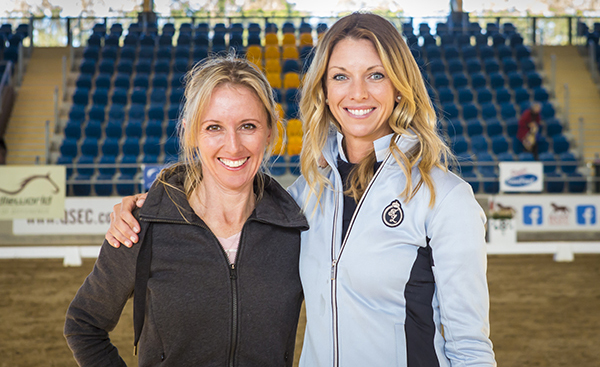
Rebecca, on the left wrote the words, and took the pictures.
Laura, on the right, a real Masterclass…
WARNING: Reading this article may take up a fair bit of your life, because once you have read it – and it is long – you are going to have to go back and read it again… and again. It’s that kind of lesson.
Laura stated from the start that she wanted to show us a little of how American dressage had developed over the last ten years and put some new tools in our pockets. Laura explained that a big part of her training is to go looking for trouble. “Everyday I ask, what is not possible?” Her aim is to be able to put her horse anywhere so that, “if I have a request from my trainer, the hind legs more under, the poll more up, I can do it.”
YOU HAVE TO LET THEM MAKE MISTAKES
The four and the five-year-old horses were presented together. Kaitlin Dooney and the four year old Lyon, and Shannan Goodwin with Somerset Flemington.
Laura thought Lyon was “super nice”and the aim was to improve the contact and connection.
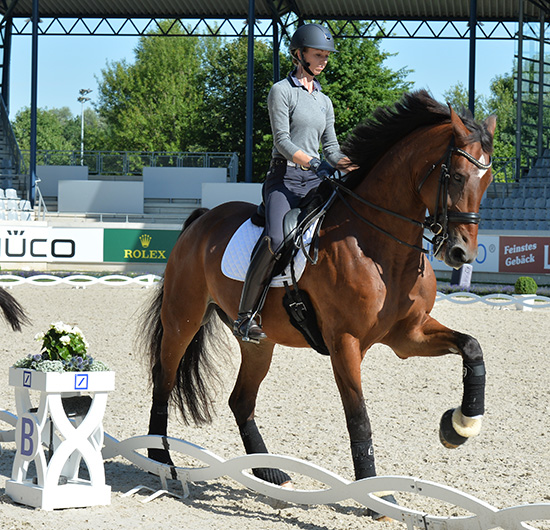
“I call the contact, what happens between the rider’s hand and horses’s mouth. Connection for me is the energy from the hind leg into the contact. The rider’s job is to show the horse the feel.” Laura and Verdades at Aachen the year they won…
“The idea is we must ride back to front, which is all true, but the second part to the equation, to get the horse sharp to the leg is to educate the hand. You get all types of sensitivity to the leg, some are jumpy, some feel safe. It’s the same for the mouth. Some horses don’t like to take contact from the beginning, some really hang on the rein. Confidence in the bridle is the main thing I want to give the horse.”
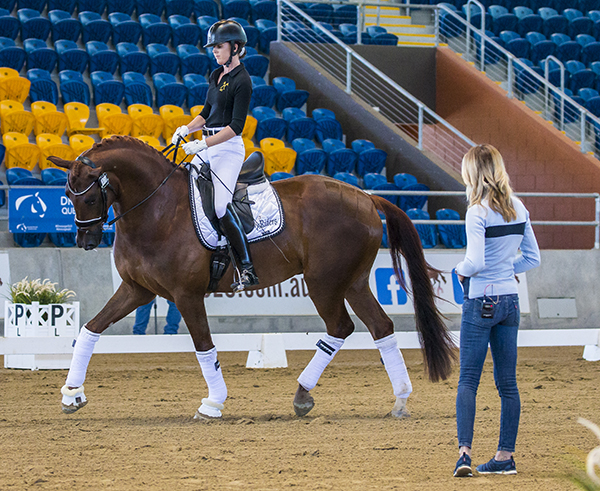
“He’s a little short in the neck by conformation, and maybe he needs to be taught through the contact, the feel we want in the mouth. We want him to stretch out the neck, but first we want to teach him the amount of pressure we want. It means he might go a bit deep to start, but later when you give the hand he will understand to stretch the neck and keep the same pressure in the hand.”
“I want you to always to create the amount of pressure in your hand that you like. For every rider this is different, and that’s ok. We’re also going to help him work more through the body. I don’t think this is discussed enough. Nobody talks about the part of the horse between the front and the back.”
Laura wanted some trot serpentines and as Kaitlin crossed the centreline she was to push Lyon away from the new inside leg, like a little thought of leg yield until she felt more pressure in the outside rein, the pressure she liked. “You can stay rising trot, I like rising trot. How’s the feeling you’re getting off your leg?
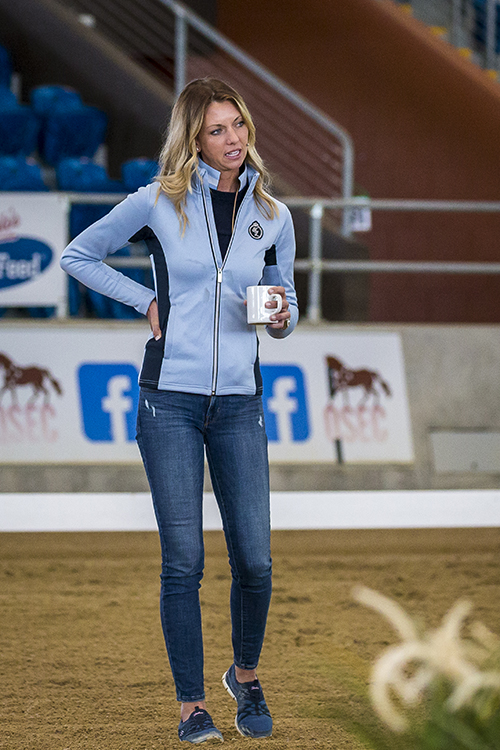
“If he goes to pull on your hand you have two choices: yes, I like it or no it’s not quite what I want. When you love the feeling, turn across the arena and find the same feeling the other way. I like changing directions a lot on a young horse. You want to bring the left side of the horse and the right side closer together until you find the middle of the horse. When you put your inside leg on, his inside hind leg should come to your hand.”
Kaitlin was playing the horse left and right, forward and back and making him seek the outside rein, which then became his rail. Considering she doesn’t normally ride the youngster, she was doing a fabulous job.
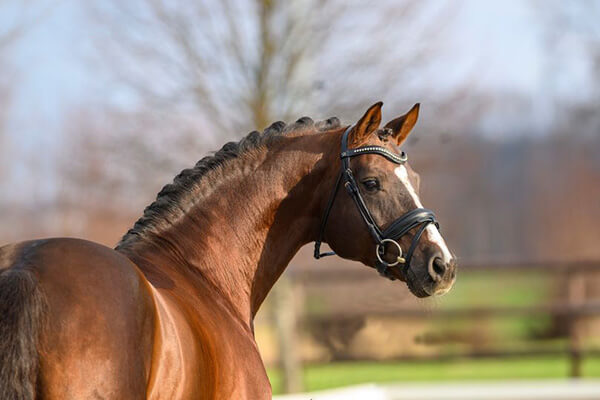
Another of the new stallions from PSI for 2024 and available to Australian breeders from www.ihb.com.au. Golden Romance de Malleret (Governor x Sir Donnerhall 1 x Don Schufro)
Lyon had a break and it was time for us to take a look at Shannan, with Flemington who was finding the big indoor a little distracting:
“Turn him so he can never be off your aids. Watch his ears. If they stay forward when you ask him something, he’s not listening to you. You need to get through to him. Submission means they are listening to me because they understand what I want. If they get distracted to the outside, it can help to position the neck to the inside to get his attention. I’d also keep him off the track.”
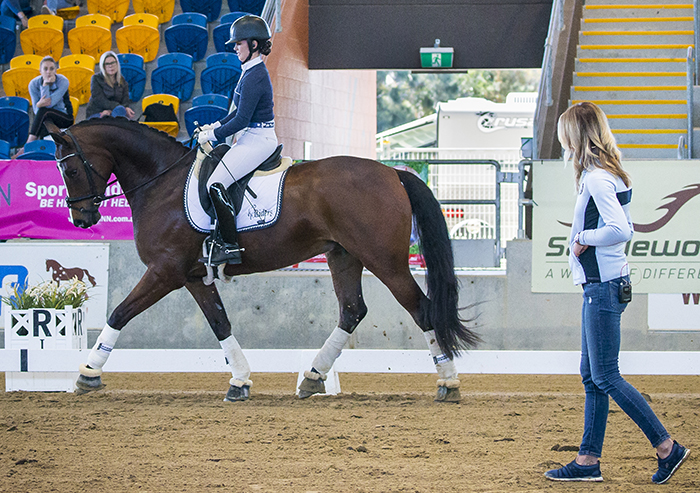
“Be careful with your leg. Don’t ride so well that you prevent him making mistakes.”
Laura wanted the rider’s leg a little away from the horse and quiet, unless it was actually giving an aid so there would be a real reaction from the horse. “Now just ask once for more trot. I think people get afraid when dressage gets ugly.Oh I kicked my horse and he jumped forward into canter. If it works from a perfect leg, great, but don’t just keep the leg on and on, so you don’t get the mistake.
“Now canter again. Keep your legs off his side. Legs away. Don’t help him anymore.”
Laura addressed the crowd, “She said to me yesterday, ‘He’s five and I love him.’I get that you’re in love, but it’s time for you to stop doing his laundry. Don’t ride so well! He learns when he makes a mistake. If he makes a mistake you say, ‘Young man, you didn’t take out the garbage.’Don’t keep after him with the leg, it’s all about the timing. If you keep having to make the correction, either the timing is too slow or the correction isn’t quite right.”
“I totally get the love affair. I’ve had my horse for 17 years. But you have to train the four and five-year old as if they will be a Grand Prix horse in four or five years. They have to start doing things for themselves.”
Eyes were back on Kaitlin and Lyon. “The job of the hand is where I receive information from the hind leg. Lightness is when the horse accepts the contact and lifts the shoulders, not when there’s nothing in your hand. It’s about giving the horse an education, not just giving them a beautiful look.
“Ask one time, not more than one time.The hands can be perfect and quiet when the horse is perfect and quiet. It’s important for me to move the bit, so the horse can seek and find the contact. Make him pull in a good way. Think leg yield, keep a bend with this horse. Take your time, not faster in the tempo. For you to maintain the contact, you might have to shorten the rein to keep the feeling that he keeps taking the rein forward.Do you love what’s in your hand?”
Time to ride a 12 metre circle…
“It shouldn’t take a six-foot guy to put a horse together. All horses should be ladies’ horses. Create a contact and he then might think, ‘Maybe I should stop’, then make him go, don’t just hold it together.”
It was another reminder of not being scared of ‘ugly dressage’.
“Is it more important to stay in canter or to keep the contact? You have to make that decision. When you have to make a correction, you need to go back, then see if you can get what you asked for from a perfect aid. Don’t cluck or you’ll just end up like a crazy lady clucking away. I like to cluck too, but when I do, my horse better fly across the arena.”
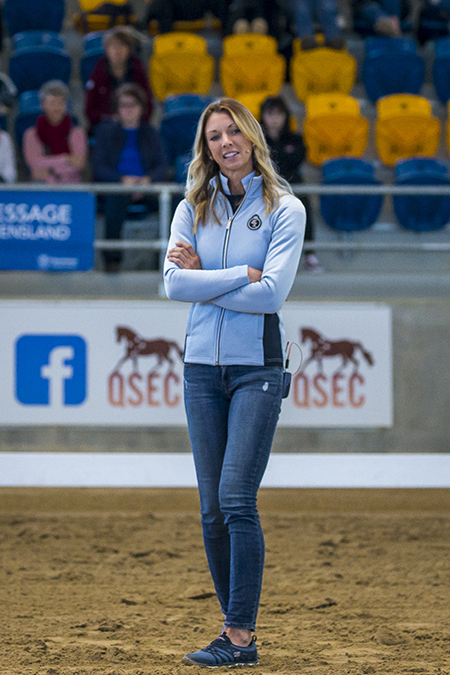
Shannan was back working on reaction in the trot,“You asked from the leg and he jumped forward, but then you stopped him.
“I call this The Goldilocks Game: one touch might not be enough, but three might be too much. Find the right amount of touch that he is surprised, but we’re not terrorizing the poor thing. He should stay in medium trot until you slow him down. Good, now ride quiet.”
Laura wanted perfect timing into the canter transition.“If he’s not on time, you have to do something about that. Just because you love him doesn’t mean you get to tell lies to him! Be really honest about the reactions you’re getting. You have to know exactly what your intention is. I’m going to apply this much pressure, and I expect him to cover this much ground, and if he doesn’t, I have a plan about what I will do about it.”
Laura was even happy when things got messy, “It’s fine. He’s got to figure it out. You’re riding super. It has to be to a point that the timing makes an impression on him. You might look at the mirror and think, oh it’s a mess, but this is how you will get something in your hand, and you can put him together. It’s like water coming out of a faucet, if you turn it on, but you can’t contain it, it’s lost.”
Lyon was now doing walk trot transitions. “It looks good enough, but I can tell you’re not totally happy. It’s the number of times we test it. It’s a little bit of a searching process, where is the point that I get the effect I want, but not too strong (The Goldilocks Game). Now make a smaller trot. Steady on the hand. Make him pull on the hand a bit, have the hind leg in your hand. Change direction and keep the feel on the bit, that’s the job of your elbows. Keep him moving in the rib cage right there where the girth is.”
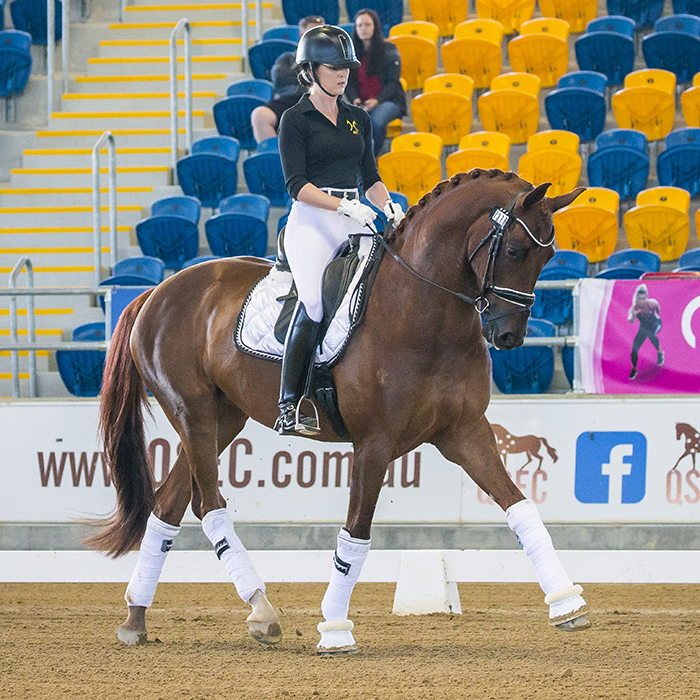
Then Kaitlin was to ride 5m leg yields and circles, sometimes bending the horse to the outside and changing her rising diagonal before switching back. “It’s like changing rein without changing rein”. It was about working the left and right of the horse then riding him to the middle of the bit. “I like that balance a lot. You need to expect the same sensitivity to both legs. He has to move away when you put your leg on. You always have to ask if he is really on your aids?”
The session finished with Shannan playing with some flying changes. “Easier canter, don’t drive it bigger. Rather, work on the reaction and balance. If he breaks, he breaks, but then he needs to be sharp on the aids to get it back. You’re too slow. You’re a bit like… and-we’re-going-to-canter and you sneak it; you slowly slide your leg back. Place your outside leg back and give it a touch. Solve this now then you’re ahead of the game when it comes to tempi changes down the track.”
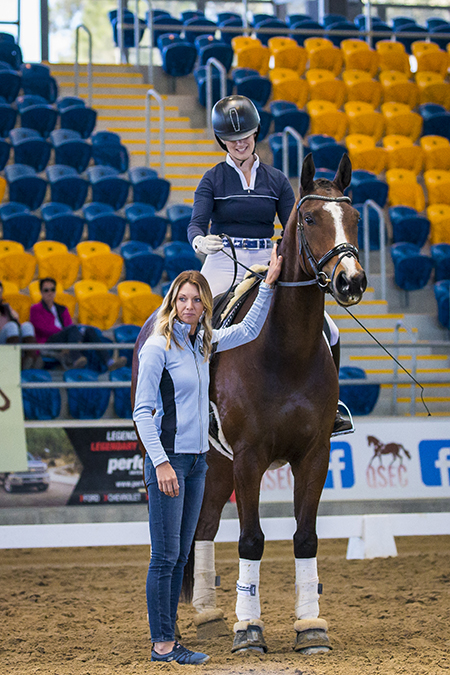
Flemington finished with some lovely, clean changes.
Next comes Jayden Brown…
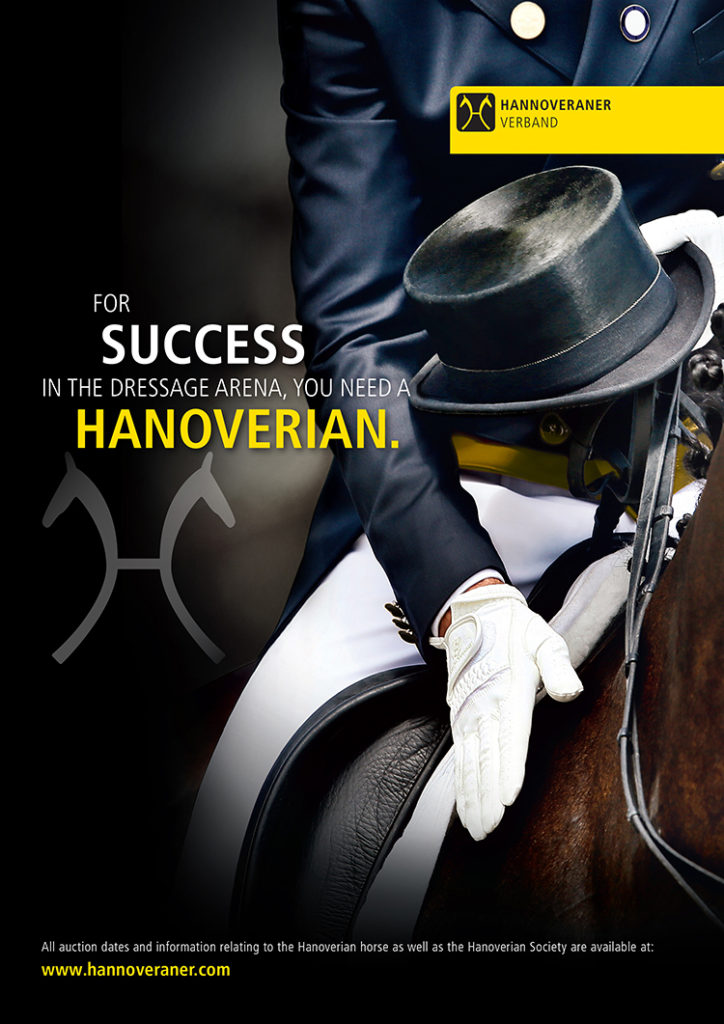
TRANSITIONS
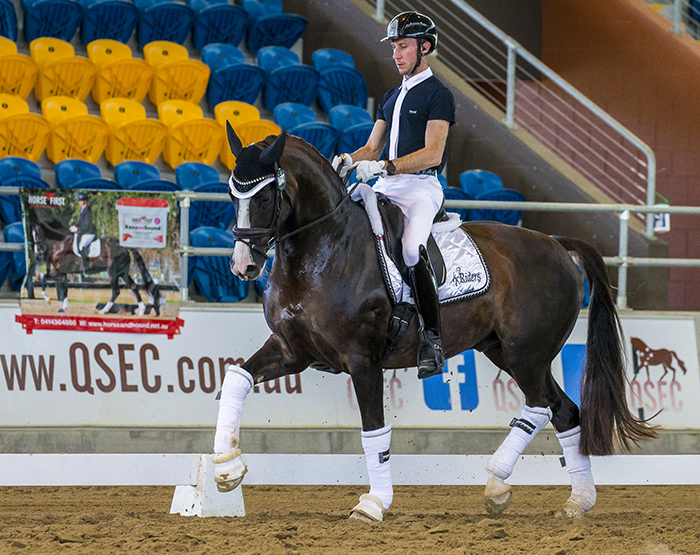
Six-year-old Bertone and Jayden Brown were next in the arena. Laura and Jayden had already discussed that the glorious gelding liked to get behind Jayden’s leg. “We’ve all had that feeling. Where I like to get to with the six-year-olds, especially when they have so much activity in the front legs, and not quite as motivated behind, is to find the right position to ride the horses. You feel like you have to go very, very fast to feel like the horse is in front of you, but for me transitions are important. It’s an easy word to use, but how do we really use them? It may not always be beautiful, but there is real learning, and they really start to have an idea of what we want.”
The canter work began, Laura explained, “Some of us who ride multiple horses a day, we find we can do things we don’t know we’re doing. Wait for him to struggle before you give the aid. You’re someone who rides too well. Be more lazy. Ask him to speed up, but with the hand ask him not cover ground. It has to become a boundary. It doesn’t come back, but there comes a time when I’m going to press with my legs and he’s not to cover ground. You have to be able to press him up against your hand. The hand is the plug to the flow of water. If he slows down, ask, but don’t do little bumps in between. The first time you ask, the second time you tell. He’s a bit of a dull horse although he doesn’t look like it. Quiet legs. Exactly. We have to have a metronome in our head.”
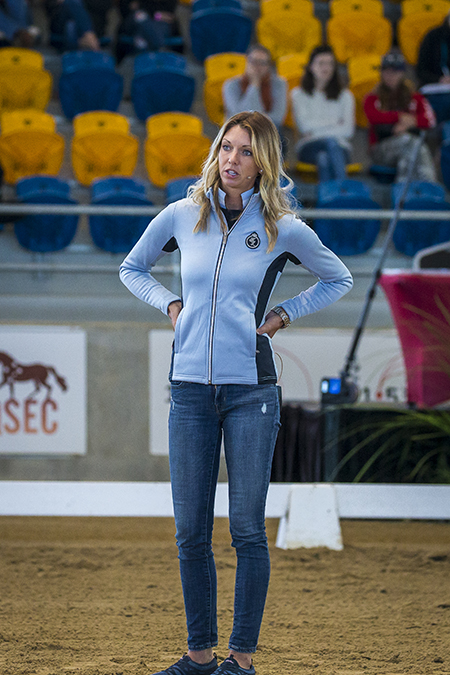
The pair stayed in counter canter around the arena, “The horse does something, I educate, then I go away. When there’s something new, I’m OK to help them, but as time goes on, I need to be available for other things. Once you get to Grand Prix, you won’t have enough legs for all the movements, and maintain to the pace. You’ll have to grow extra legs. That’s nice. He already looks much hotter. They have to feel just as hot when they’re not covering ground. Keep the shoulders in front of the haunches. He has to stay under your butt.”
When the feeling was good Laura asked for a flying change.
The education of sharpness and good balance was a constant. Near enough wasn’t good enough. Precision was key. Laura really aims horses for the top level, even at this age. Bertone was trying to find his balance. “He’s either totally behind you, or going really fast, so try and keep him under you. Don’t always go to the easy place. Listen to the metronome of the hind legs, they shouldn’t get slow when you bring him back. If he goes to canter and he doesn’t feel in front of you, gallop. Little bit back. You’re not quite getting through to him. He’s not surprised enough.”
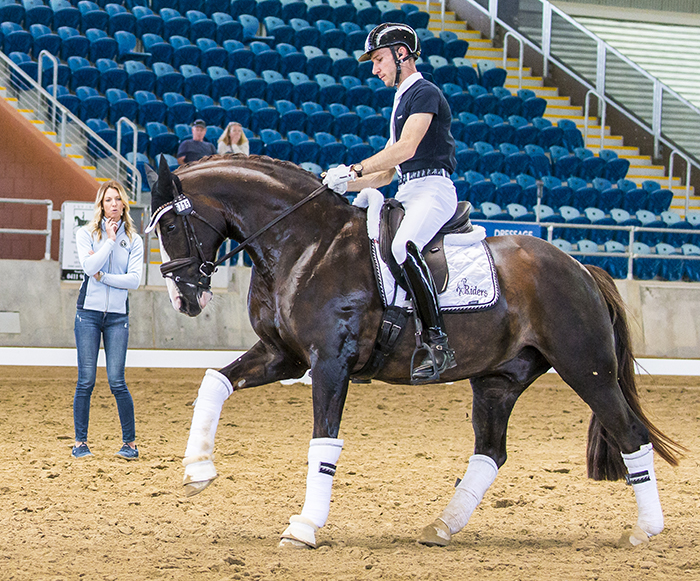
“Trot forward with reaction. Keep a little bit of shoulder fore. Get your reaction, then in between ride like a sack of potatoes. If you get too much tension, find a circle. Activate the hind leg with your leg and be friendly on the front end. Minimize the front end. Then travers. It’s animal nature to find the easy way. We’re changing his life a bit, so of course he’s going to make mistakes, it’s ok. We’re on the edge here. I don’t want to set the horse up to fail every day, but I do want to press him a little.”
Laura took a look at the half passes, “You have to go looking for the trouble, what’s not possible. We have to go looking for it, so we can address it.”
The most important thing to the American was the line. “Only move the haunches as much to the inside as you can control the line. The line is more important than the position.”
“What’s the most important thing about the shoulder in or half pass? Everyone says bend or shoulders. For me in the Grand Prix, if I don’t get from B to H, I get zero. Every time you turned right he came too much with the haunches. Ride for the quality of the gait. You’ve seen it in horses at competitions that they start the test well and then in the half pass, the quality of the gait disappears. That’s because they’ve lost their line.”
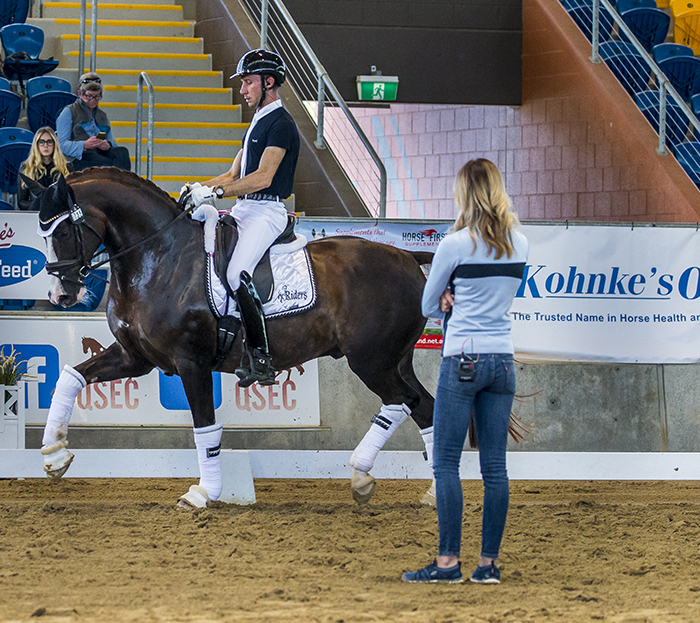
Next some working pirouettes before the end of the session, “It’s never touching the horses with anger or frustration, but in the hope that they’re learning. Your legs cannot be maintaining the canter in the pirouette, so let’s get that first. You might have to challenge the canter to where you have a little bit of difficulty. You have to stay in between the teeter-totter of too fast or too slow. The training wheels have to be off because now you need your legs for positioning. Nothing about the pirouette should be more difficult than the canter.”
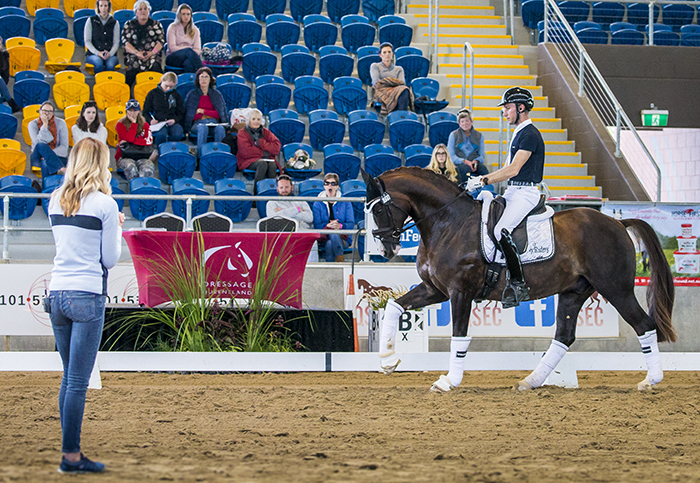
First Jayden had to get that quality of canter and Laura wanted a better reaction from the gelding, “I don’t think he’s quite getting the memo by the look on his face. Either the timing is off, or the correction isn’t quite right. I might put my whip in the outside hand if I was you. I think your correction needs to be a bit more. He’s not quite in the middle of the teeter totter, he’s one side or the other,”and Jayden was onto it. “Good boy. Mistakes are not punishable by death. See your line. Good. I think that’s quite nice.”
And a final message, “I think it’s the job of every man to train a lady’s horse. That’s a real test of a male rider. That’s my goal too, get more from less. Get to that place where they don’t have to run to feel in front of you. He’s a super nice horse though, so if you can do that, he will be able to do it all.”
Next is Elloise Devlin
Want to breed a dressage champion? Like Floriscount? Go to www.ihb.com.au
QUALITY
Elloise Devlin was on her eight-year-old Advanced horse Brimstone Florente, a gelding she had broken in herself. Laura had seen the duo the day before, “I loved him the most yesterday when he was spooky. I thought that’s the best he looked. So I would like to see a change in the shape of this horse. We’ll start with some suppling work, then work him in a more collected shape. He has to work from the back to the front not just the back and going nowhere.”
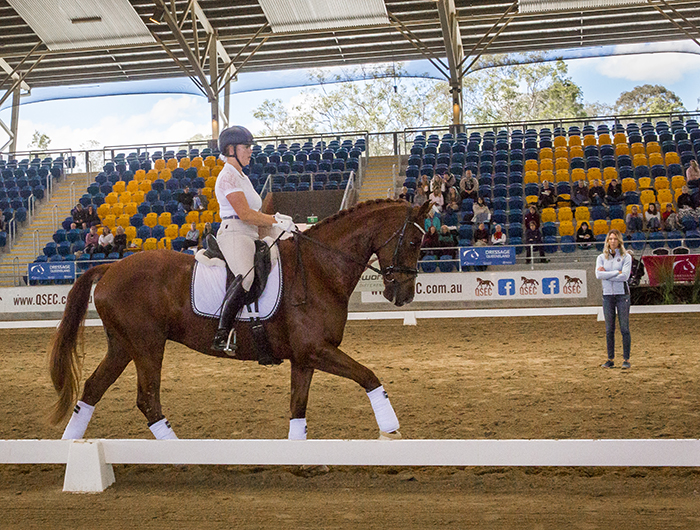
First stretchy trot and canter, Laura wanted to see the whole horse involved, “It’s not just long and low, but also that he’s bending through his whole ribcage. He tends to be a bit straight. Play with him in the contact until you love the feeling. They need to be 1000% trained on the leg and 100% trained on the hand. Put him on your aids. So rather than tell him to stop spooking, give him something to do with it.”
“Now start shortening the reins and keep the bend in the ribs, soft elbows. Make him as sharp to your hand as he is to your leg. When you take his shoulders off the rail, your outside rein and seat bone and leg are the rail.”
The work then moved into shoulder in and haunches in, “For me the shoulder in is a body building exercise. Inside leg is forward. If adding bend makes my job easier, the horse probably just crooked. If making bend made things easier, everyone would do the Grand Prix half passes.”
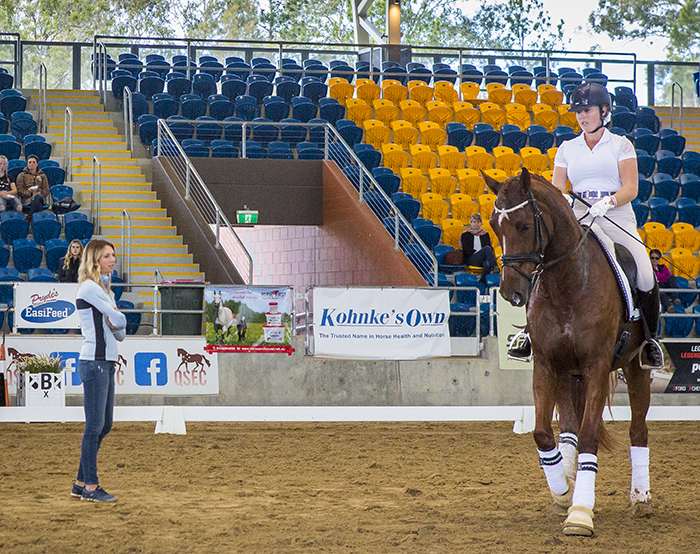
Laura wanted to get the horse’s whole body involved so moved to a 10m circle.
“Almost counter flex, put his nose in the middle, make his neck completely straight off his shoulders, we need to get the shoulders off the track in shoulder in. And in the travers, he should just bring the haunches, not his whole ribcage. If that happens, use a little inside leg. Moving his neck to the inside will make him feel like he’s bending, but keep the neck straight and really check your work.”
“At this level, we’re training for quality. It’s not enough to just have a nice shoulder in now. There’s no shoulder in in Grand Prix, so what’s the point? You have to think how it’s going to help you get 70%+ in Grand Prix. (It’s the quality). I would always train a little bit more difficult so the movements from the test are a piece of cake.”
Then it was time for canter half passes making sure the horse was straight on the outside rein. “Sit back on your elbows. Your elbows are part of your seat.”
Laura wanted a better corner before the half pass so asked Elloise to try again. “Come again, that was all the neck. Do you feel how the shoulder is six inches to the outside of your line? You have to master the turn before the movement. Don’t let your reins get longer, keep your elbows by your side. Sit on your elbows. Work the poll softer a little, but without him getting lower. Don’t let his front legs get away from his hind legs. He also is a little comfortable in a bit of a run. We’re going looking for trouble here, so we can’t be surprised when we find it. It’s fine.”
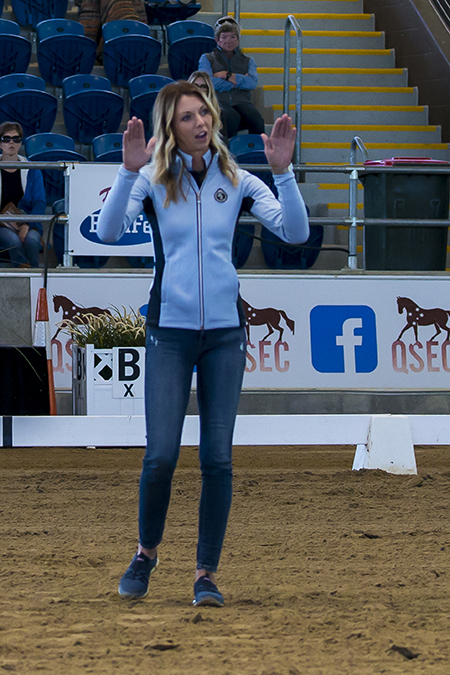
Then a flying change and Jackson got a bit spooky. “Ride a turn, don’t take the spook out of him. He has to be soft and like butter when he’s straight. We have to disconnect the neck from the body for true thoroughness and connection. Think shoulder fore when you’re straight.”
“Now if you’re happy with it, start thinking about your half pass, but don’t overthink the half pass. The quality is more important. Inch by inch you can turn it into a half pass, but you can’t ever lose the feeling that your left side and your right side are like rails he must stay between.”
From the half pass Laura wanted Elloise to counter canter along the long side and play with the flexion before preparing for trot transition. “Half halt,”she asked but then followed it up with, “I hate that word. All you have is two legs and two hands so anytime I touch the horse it would be a half halt (Read my interview with Laura for a further explanation). Make one of those half halt things; elbows, seat, leg then trot. Good. Close your elbows, close your legs, don’t let him run, play him with the bit. A large part of changing the horse’s balance is uncomfortable for them so when you start changing things, he’s going to struggle a little.”
“Someone once said to me horses have to be smart enough to learn, and dumb enough to let us train them. We want them to do difficult things, with animal nature maybe the smartest thing would be to do the easiest thing. He will be confronted by something that used to work but doesn’t now. You have to be fair to know it will exhaust them, but you have to start training this different shape. If he trains in the same shape he’s in when in a paddock or the stall, we’re not doing him any favours. Just stick him on the lunge line with a halter. We want to work them instead in a way that keeps them sound. We seem to have this thing that we have to prove to everyone that we have beautiful horse and we ride these big movements, but for Grand Prix, you need to have many trots for example.”
“So now when you ride him more together, if he asks to pull, you have to say no. Your elbows activate your core. As women we don’t have a lot so you hopefully can engage your core then when he pulls you can put your leg on and say, ‘use that in a different way’.”
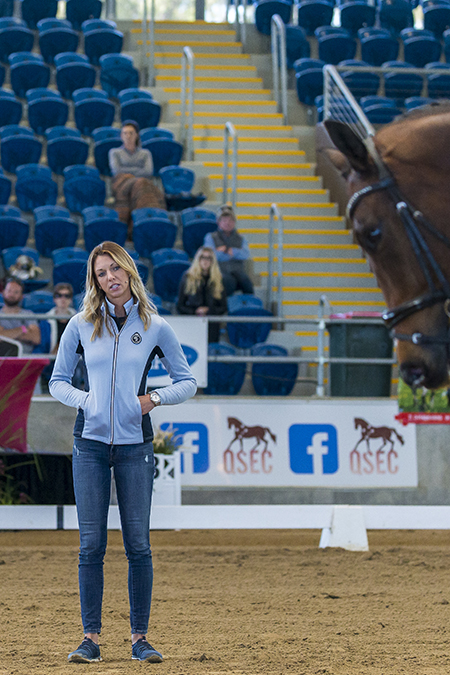
“The hand is where we feel the problem, the leg is where we fix it.”
“The reason he’s strong on your left rein is because he’s not enough in your right rein. Inside leg is always forward. When he asks, ‘can I pull’, and you say ‘no’, that’s when his trot looks the best. Ride the quality of the trot from your seat and your elbows.”
Then some more half pass work, “Sit to the right when you go to the right. Sit him back a bit, bring his inside hind leg closer to your hand. When he bounces like that, you can follow with your hand, if he reaches up and tries something new, I’d allow it, if he reaches down right here, I’d say no.”
“The half passes are no problem. I think the problem is when you take him into this limit. When the reins are longer, he feels more bendy and supple, but that’s not suppleness, that’s crooked. He’s got high quality gaits. He has gaits for 8, so you should be aiming for every movement to be no less than 8 because all you have in a test is walk, trot and canter. So if he’s long in the contact, or allowed to run, or you don’t stay on your line (and keep the horse in the middle of the bit), you’ll sacrifice your 8. God has given you a free 8 with this horse!”
After a walk break, a check in with the working pirouette. “His outside shoulder is almost back bit. Can you feel that? Pressure your inside seat bone. No matter what you change in your contact or with your leg, you must not lose your line. This is where we so often see horses not come into or leave the line of the pirouette. You can stretch him on a short rein as well as a long one. Manage him on the outside rein. Put his hind legs into the bit. On your hands, not through your hands. Half of that equation is not letting the rein longer. You should still have a stretching feeling even when the poll is the highest point.”
“Now stretch him down. Put his nose in the dirt, but on the contact. I think he is so lovely, but I think you have to change this mindset of, ‘oh he’s only eight-years-old’. You need to challenge him to find a different balance to now get better quality. He’s now not allowed to run or slow down. He needs to be in between your leg and hand, not in front of or behind them. He’s got the talent to go all the way. You need to train him for 8s and 9s. There’s no reason not to.”
Jayden is back next
Want to breed to the best bloodlines in the world this season? You can, including many ‘D’ line stallions, including Dancier. Go to www.ihb.com.au and find out more.
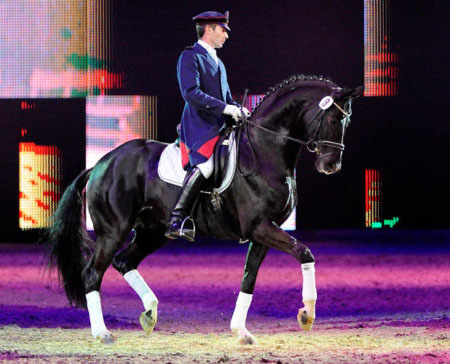
RELAXATION
Jayden was now back with his small tour mount, the eight-year-old Dancier gelding, Davinci. “For me it’s about finding another gear in my horses. Dressage at this level should be just as exciting as watching horses jump a Grand Prix course. If people don’t want to stop and watch, we’re doing something wrong.”
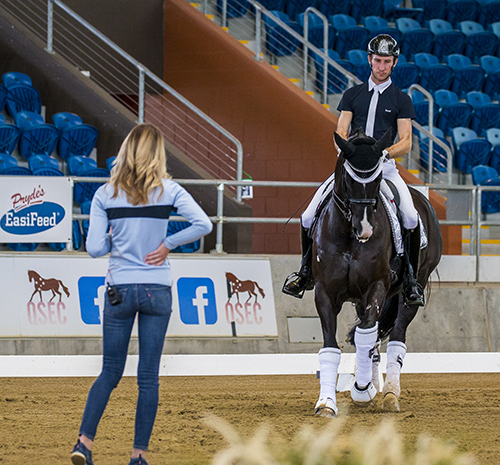
“This horse’s top line is challenging because he holds tension there. I can look at this horse and say he’s a nice quality. He was kept as a stallion in Germany for a reason. But good enough isn’t enough for me, I want greatness. I hold myself to that standard as well. Like I said before, if you’ve got a horse that has an 8 walk, you should be getting 8s.”
Laura wanted the horse to be gaining confidence in its work without getting worn out. Her aim this session was to find a position in the top line that decreased the tension.
“Tempo and top line control are two of the most important things in my training.”
Jayden was off into canter, “Even when you collect the canter, like the six-year-old, he needs to fill up the amount of space you’re giving him. If you’re giving him a 6×6 box, he has to fill it. I’d like to see a more active hind leg, but play with the top line. I only want the neck up and poll the highest point if there’s relaxation. They have to engage the core and the lifting of the neck is a by product. Hands down, always in front of the saddle. You have to find that sweet spot where he works the back end, but he rolls across the ground, he doesn’t stab the ground. We’re not working the horse how we want to present him in the show ring, but we have to find a doorway where the horse wants to give us his back. The rhythm should not change when we change the tempo.”
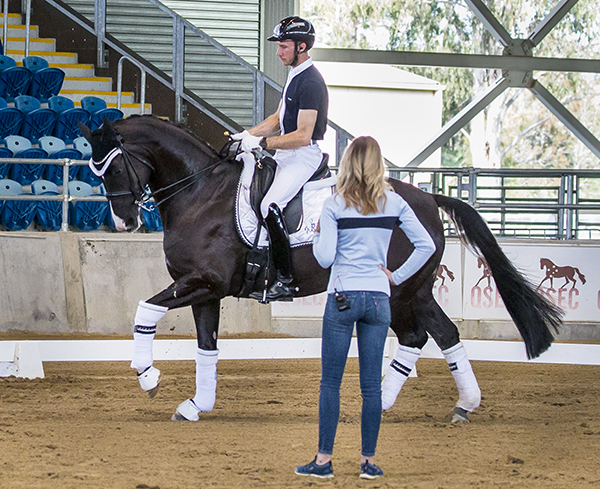
Laura was really getting Jayden to play with the horse; leg yield at canter K to R in left canter, then 12m volte at A. Then serpentine but 12m voltes on the loops between counter canter and true canter before playing with the pirouette positioning.
“The best way to relieve tension is to put the horse on a curved line. You have to find a way to access the back. I want to find the place where the horse won’t let me touch him. Do we always want him that low or deep? No. In the pirouette you can get away with it a little bit. But in the training, it’s about allowing the horse to understand what I’m trying to teach it. If when I touch the horse, the horse gets tighter and the rhythm gets altered, we find a way to work him on that rein where he gets more relaxed.”
“Horses are not born symmetrical, so if we ride one side the same as the other, they will stay asymmetrical. It’s possible it will help, but the fix on one side might be different than on the other.”
Pirouette left was next. “Ride the canter not the pirouette. More rhythm without him getting faster. If you’re going to make a correction, make it and expect a little trouble. Slow down, I want to see something. He doesn’t take a full step with the inside hind, so leg yield out again and get that inside hind leg under his belly. He’s so much better when you put that left leg on, and feel him in your snaffle. Don’t be so concerned about training the movement the same each way.”
“I train a lot with sugar when they do something great. But it’s important as riders to not just settle for good, that we look for the trouble. Don’t discipline for the bad reaction, but look for the good reaction, because if you’re in a test and you press him with your inside foot and the first stride is bad, and the second stride is better, that’s not good enough for me. I need the first stride good because that’s what I need in the test.”
Laura aims to feel what’s going on under her, not just follow a text book translation on how to train a dressage horse.
After a walk break it was back to the trot with still the focus on tempo, rhythm and getting the gelding to give his back a little more. “I want you to think the tempo of the hind legs is the speed at which the rhythm is repeating itself. I want a whisker quicker rhythm. You play with that a minute, maybe it’s travers, play until you feel it steady and you feel you can ride the back. He needs to lift by using his stomach muscles and shoulders not just by raising his neck.”
Half pass again, when you like the feeling in your hands, push your hands to (the letter you’re heading to). So don’t settle at the place that causes trouble. You have to push it or else you don’t find anything. I think you could do a test for 65% or you could push him so he doesn’t feel tension in the excitement and desire, then you’re looking at 70% plus. I would rather ride a horse intensely where they’re turned on and tuned in for 25 minutes, than moderately for longer.”
During the walk break, “I only allow them to walk in the arena time in the walk that’s in the test, so at this level I want extended walk and when I pick up the reins I want collected walk.”
Then it was time for half steps and a focus on good reaction.
“Forward and back with trot. One time you ask and if he doesn’t react you ask more but then if he jumps forward and reacts, he’s never in trouble because we created that reaction. Try to maintain as much suppleness in the hand as you can if you’re going to be firm with your leg. If he wants to take, he’s allowed to take. That’s our advantage, we can prepare. You know you’re about to come strong with the leg, he doesn’t necessarily know that. Then try to relax him again, so a little haunches in or out. Move the hand, pet him.”
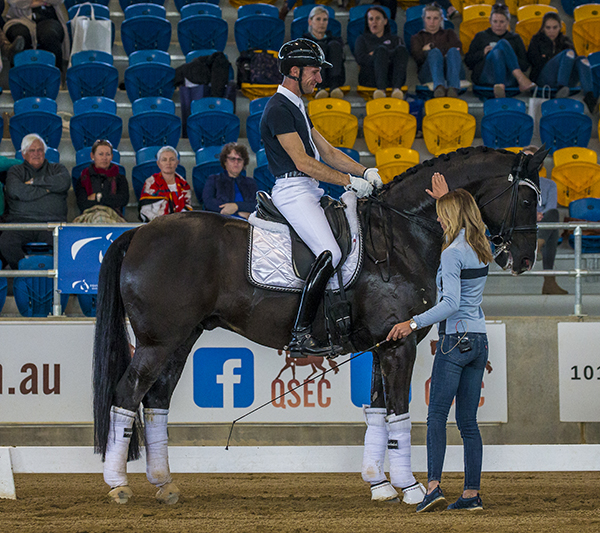
For the half steps, Laura helped with a whip from the ground. “I do a lot of that with all my horses. They’re not in trouble, it’s a game.”
She tapped the hind leg and just wanted Davinci to pick up the leg, but instantly. “Good boy. You’re so big and handsome.”Then to Jayden with a sly smile, “You guys like that, don’t you?”
“I think he’s a bit dull with this so I think there could a be a lot of work done here. We have to really practice these things. I know if I was going to help you from the ground in piaffe, I wouldn’t get a reaction from him unless I smacked him and made him nervous. Instead, I want this just to be a tool, so when I touch him with the leg, I want a reaction, not tension because then it’s not a tool at all, it’s a weapon. I want him to pick the hind leg up and be quick, not run away.”
The session finished with a look at the passage from trot. “Get out of your teeter totter. The passage is more because it’s the same trot, but we’re giving it less space. Because this horse is slow behind, I want you to think quicker in passage, not slow. Post the trot. Feel the tempo in your posting and when you make passage, you’re not allowed to slow the tempo. When your butt is out of the saddle that’s when the inside hind leg is in the air and you can touch with your leg. Keep the passage and trot really connected. You have to be able to get from walk to passage or passage to piaffe or passage to canter, or else the passage is pointless. I think you need to focus on what’s a challenge for him. If you stay to far away from it, he’ll never get comfortable with it.”
There was that message again, look for the trouble zones rather than avoid them. Then the scores will go through the roof.
PRECISION
The final combination of the day was Lizzie Wilson-Fellows and her InterA/B horse Let’s Jazzabit to show us some of the Grand Prix.
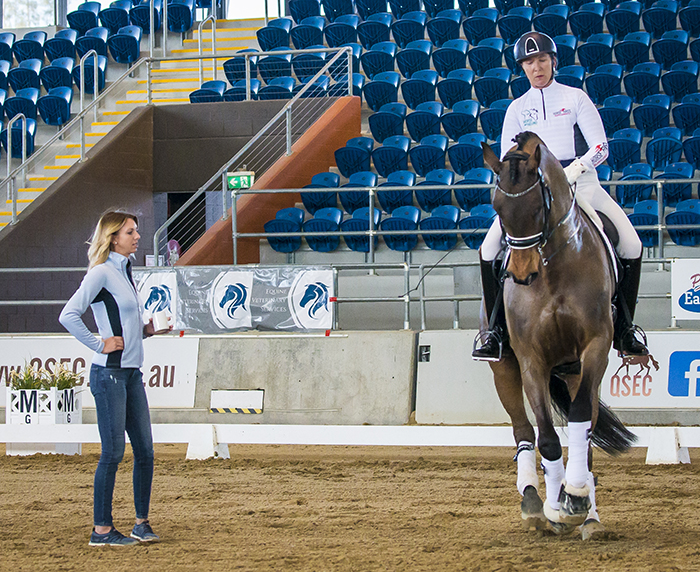
“When you reach Grand Prix you think, finally, my job is done. Then about a year after that you realise the work has just begun. How can I do more by doing less?You have to expect super high quality at all times and you have to commit to one thing. I don’t care how much leg you like to ride with, or how much weight you have in your hand, I don’t care if you want your canter aid to be touching him on his left ear with the whip, I don’t care as long as it’s the same each day.”
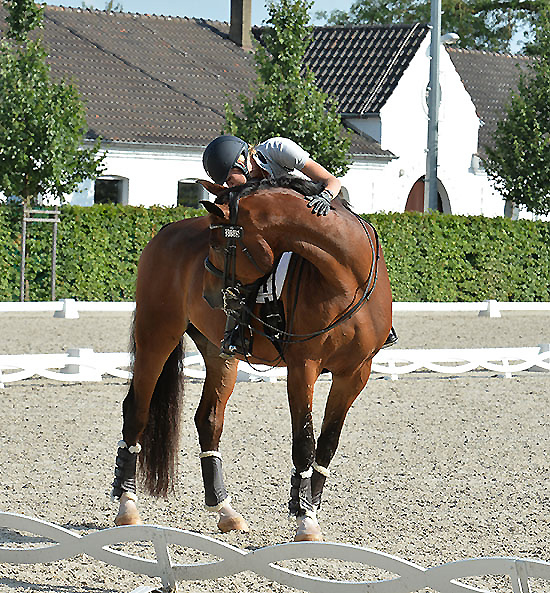
“I probably ride the hottest, spookiest horse on the top circuit today, but I can do it because when I do something, he knows exactly what I mean, every day. You don’t compromise.”
Laura encouraged Lizzie to do the least possible in her riding and see where her horse was. “Incorporate a little half pass in the warm up. Make him chew on the bit. Play and give. Check your work, take your legs away, give your hand, see what you have. It’s like testing a recipe, tasting it. If you don’t love what you test, you have to figure out your recipe. It’s not about the shoulder in positioning, it’s about the tools you have (two hands and two legs) working perfectly. If you flex him left, he’s not allowed to lose the tempo. If half pass is what’s happening in the canter, your priority is the canter. Manage the steps. Find the line better with the shoulders before leaving the track. Play with the bit until you can ride him with your pinky finger.”
Then shoulder in left, “A little left positioning, left leg, until you can feel him in the right. Your life line on a Grand Prix horse is what’s happening between your hand and the mouth. Work until you love the trot. Play with the passage, then the trot. Smooth transition, take your time. Everything at this level, the horse has to stay on the bridge. He’s got to stay equally between the leg and the hand, he’s not allowed to jump off the bridge. You want to feel a stretch even on the short rein. He needs to take you. Find a place that’s connected. A little forward and back.”
“When you have a horse that’s nice, but on the edge of tense, it’s like the last horse, but in a totally different way. I need you to ride bravely. If you ride slow or tight, and not too much toward the medium, you won’t get there. Just because they’re hot or talented doesn’t give them a free rein to not being trained. We just have to train them more. First time you touch with your leg is an aid, the second time is a correction.”
Lizzie made a good correction with her leg, but Jazzabit didn’t give a big enough reaction, “If I kicked my Jazz Grand Prix horse like that, I would kick the judge at F. It’s not the number of steps going forward, it’s the reaction from your perfect aid.”
Mindful that the gelding had had a big week competing, Laura asked what the most difficult thing was. Lizzie chose piaffe. “It’s the placement of your legs that’s going to make the piaffe. You put your legs on one time for piaffe,”and again you realise how sharp those top Grand Prix horses are when Laura comments, “He’s too late. Give him the hand and go. Give him the hand. Now it’s over and ask again. If he’s on time every time you ask, don’t think that you have to maintain the piaffe. You ask and he starts. If he quits, you start again. Don’t kick every stride in piaffe because if he stops then, what do you do? You have nothing. You get zero. That’s no fun.”
Lizzie got the horse sharp pretty quickly, “Now he’s on time, so now we’re challenging the piaffe and how he does it. Now we are taking him to a more difficult place so we have to be patient. Post your piaffe until you find a passage. This is very common when they learn the piaffe. They can’t get out. Like I said earlier, the passage isn’t helpful if you can’t get from point A to point B. The piaffe isn’t helpful if you can’t get in and out. We have to be very fair how we pick on a horse. Reaction time is non negotiable but then we need to help him.”
Still at this level Laura wanted the horse bending and turning and not stuck on the track, “Turn. If I could do the whole Grand Prix on the rail I’d get 100%. Passage in a serpentine. As you turn keep him in the middle of the snaffle. You get a 10 on the rail but when you’re off the rail you get a 6 or a 7. You have to spend more time in the places that are uncomfortable. You need to be able to change his shape and then sit quietly. But he needs to be accountable. If you’re driving every step in the passage, your leg is on, it’s not as significant as if you add it and surprise him a little.”
“I really think it’s important in the piaffe that I come quickly with the leg, but when I hit a place where the horse is really trying, he’s trying something even if it’s a bit wrong or he’s not understanding or he’s guessing the wrong answer, then we have to be patient. The first place I’d go is to post. The other way that can be helpful if the horse is comfortable with someone helping on the ground, they can take them with the snaffle like they’re walking them forward. But the piaffe has to be married to the passage. Help it make sense to them. We want them to be reactive but relaxed.”
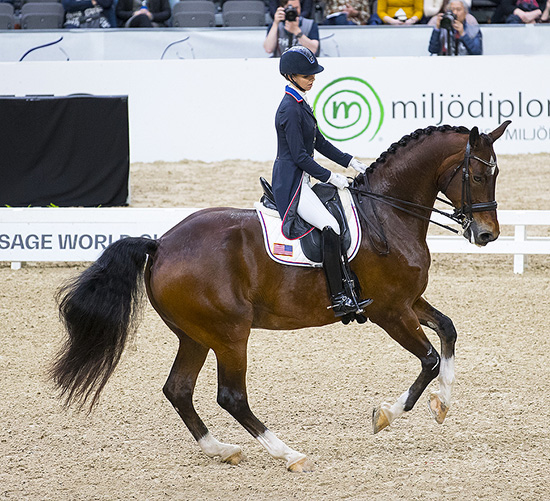
Laura and Verdades show how – DigiShots image
Pirouettes were next and at this level they had to be tighter, precise and in total control and Lizzie was not going to get out of it with anything less than perfect!
“Don’t block him with your own upper body. It’s nice enough, but I feel it’s not totally in control. I’m going to be picky on you because I can. If I asked for it here or three in a row or on a different line, it should all be there. First find your canter. It has to hold.”
Laura was onto every step and Lizzie made the mistake of taking her circle larger, “What the hell size circle was that?”Laura reprimanded with a smile, “You guys have the metric system here. I’m American! Do less. Right shoulder back then sit easy. He’s a Grand Prix horse. Do nothing. Legs off. Wait for him to break.”
It was really hard for Lizzie not to react before he broke when she felt she might lose him. She had to let the horse make the mistake. She did it and that’s when things improved.
“It’s all about playing that game. You can let them make the mistake or he’ll try the minimum and you can say that’s not bad, but you could do more. But do it in the pirouette canter. It drives me nuts when people are struggling in the pirouette canter so then they race off at full speed. How does that help? The horse doesn’t relate that to the pirouette.”
The pirouette left had to be ridden a little larger to keep it rideable.
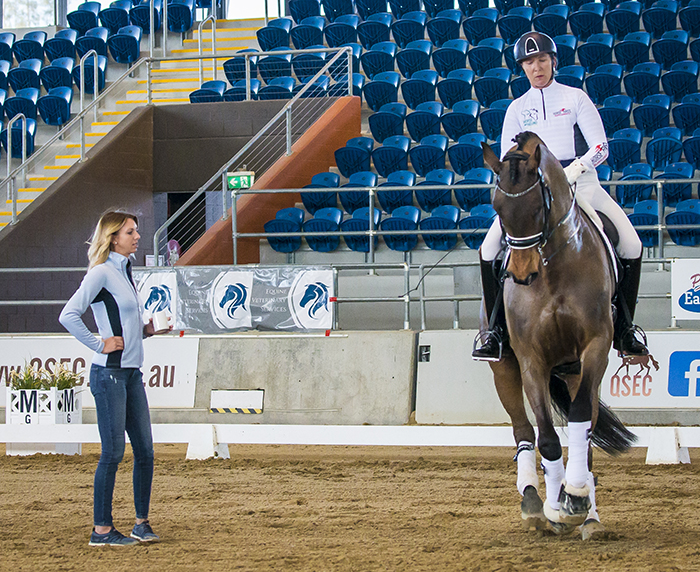
“It’s about the canter, remember. You’re never allowed to feel out of control. Steady on the snaffle, that’s your lifeline. Activate. Come on, poke him, don’t just keep the leg on. If it’s going to activate it’s poke, poke, not a dull push. Make it fresh each time. It also helps to keep you loose in your own body. If your leg is loose enough to come off and on, you have to have loose hips and knees.”
The session ended with a look at the tempi changes. “When you get to Grand Prix, the corners are the only chance you have to prepare for anything. If you can’t get it done in the corner, you have problems. Ride him up to his ears. Now have the idea you can get the same done with less. You lost it a bit at the end but it was because you lost the rideability of the canter, so I would ride seven tempis and then get the canter, ride seven, get the canter. It’s better for you to ride this type of relaxed canter. It’s more productive to have the same canter for the first and the last. It’s no point starting with 8 and finishing with 6, you’ll get a 7. God gave you a natural 9 with this horse so you’re starting with 90%”
The Masterclass was about looking for the trouble; looking for what’s difficult so to help the horse. Not being afraid to make mistakes, and using them to educate the horse. That’s a proper training session and that’s what we got. Laura really showed how precise and sharp the horse needs to be in its training and how much control the rider needs for each movement, but by doing as little as possible. No wonder she’s so good!
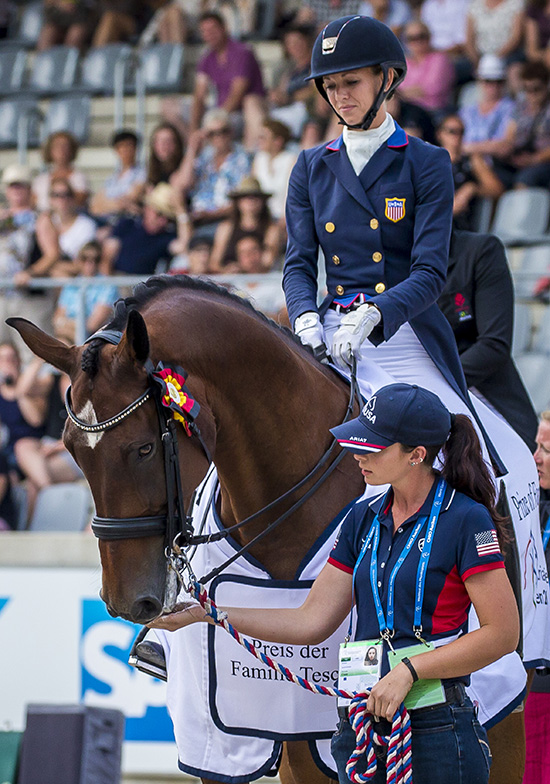
Thank you to Kaitlin, Shannan, Jayden, Elloise and Lizzie for helping us learn. It’s never easy to have a lesson in public. But these are talented riders, and they showed us some great work!
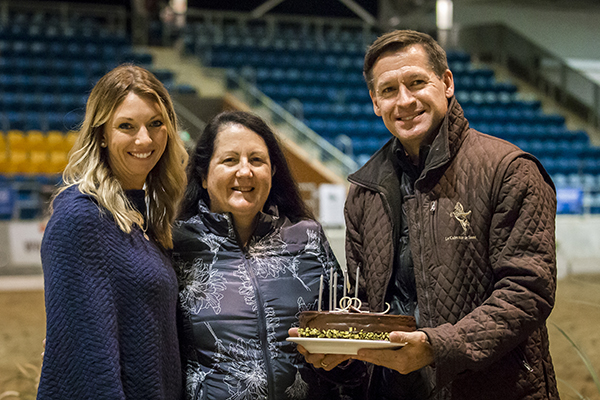
Happy birthday Laura – Leesa Murray and Peter Bowcher present the cake…
Thank you also to Leesa Murray who is so brilliant at bringing the best in the world to our doorstep. Always get to these events. They’re priceless.

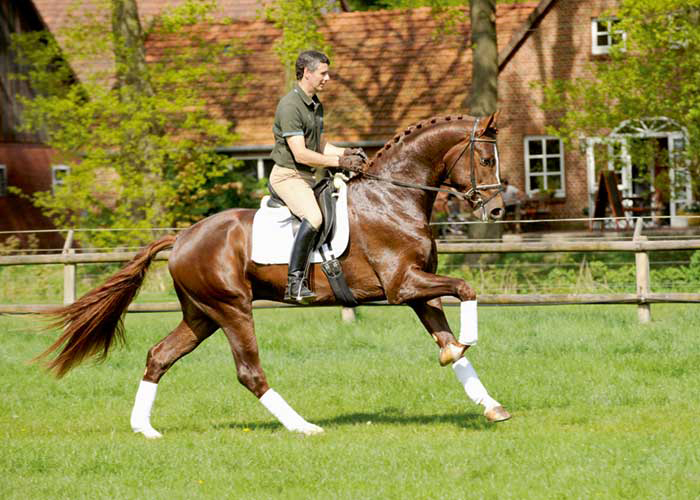
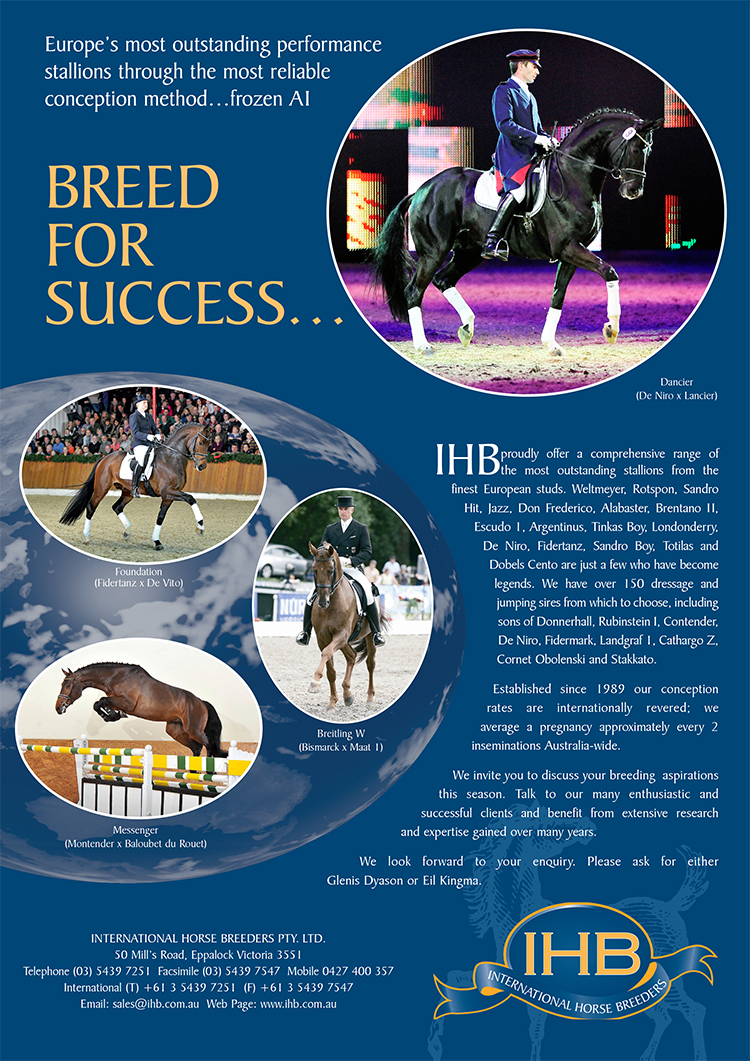
Really enjoyed this review as we couldn’t get there on the day.
A great job Leesa…. bringing her to Oz. Thank you.
Thank you I had read the article,where is her interview?
Fabulous article. Thank you Rebecca and of course Laura and the riders. I had the best ride this morning thanks to you all. 😊